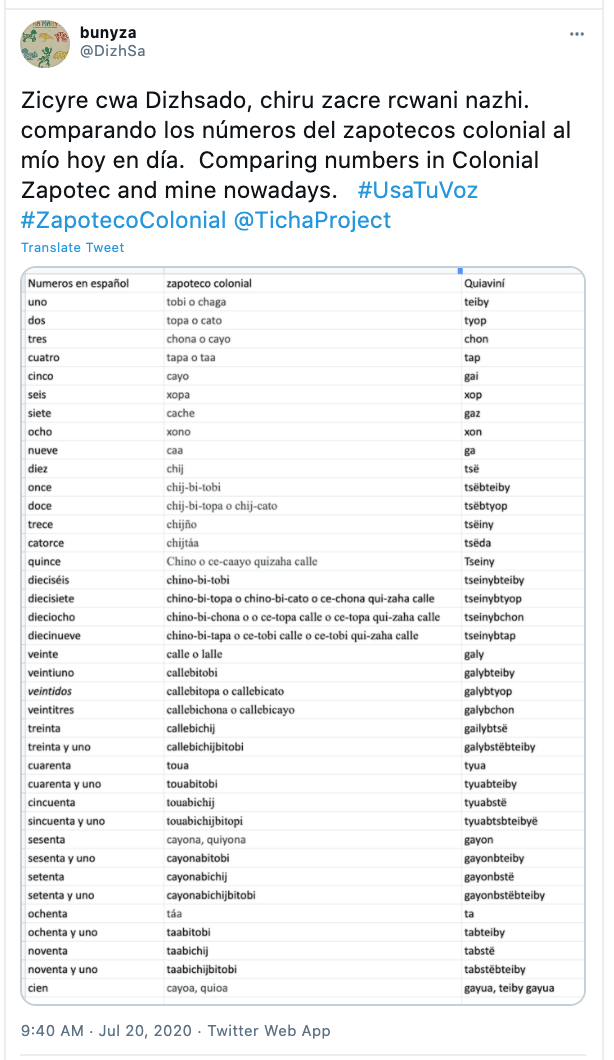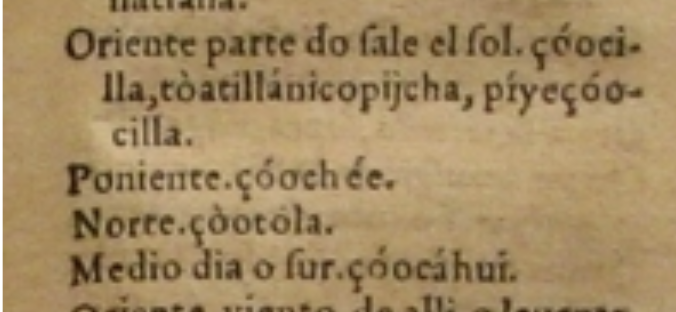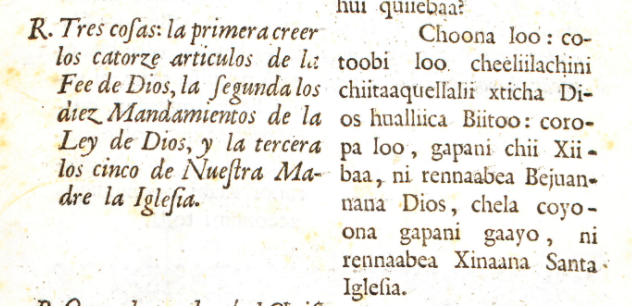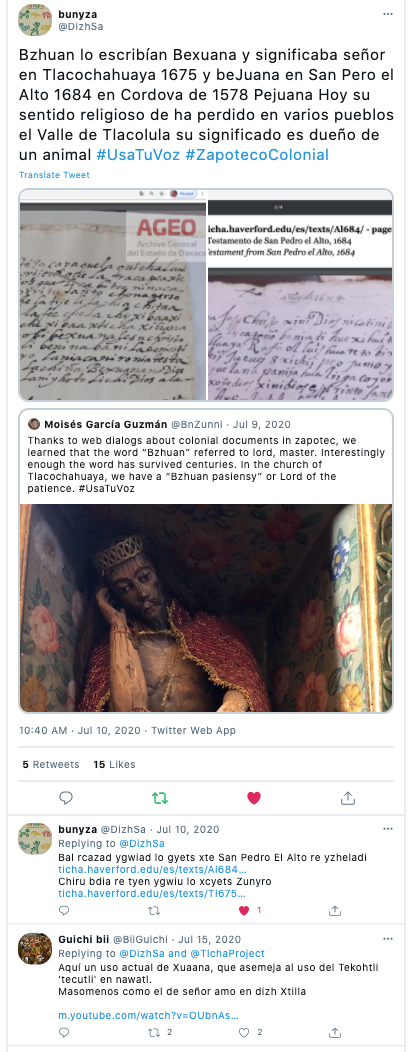Reclaiming our Languages
Felipe H. Lopez
This chapter is written for those who speak Zapotec or for people who are learning an Indigenous language; however, others can also benefit from reading it. It will be very helpful to complete the modules on Ticha and Language Shift before reading this chapter. After Reclaiming Our Languages, readers may find that the chapters on Numbers and Twitter and Zapotec Language Activism will give them a way to continue their work.
Resources in this module: Teaching Summary · Answer Key · Spanish Version
1. Introduction
According to the 2020 Mexican census, only 6.1% or 7,364,645 people in Mexico speak an Indigenous language (Inegi 2020). In the case of Zapotec, we comprise a little more than 400,000 speakers of this language family and all of its language varieties. Despite the existence of the General Law of Linguistic Rights of Indigenous Peoples in Mexico created in 2003 to recognize and protect our linguistic rights, the number of Indigenous people who speak a Native language has greatly decreased. As discussed in the chapter Language Shift, there are several factors that have contributed to the loss of Indigenous languages in Mexico.
Some of us have taken initiatives to counteract the effects of the loss of our languages, and we have been working to maintain our languages. However, we have little financial and material support. With today’s technology, some institutions have started digitizing documents written in Indigenous languages. For example, the Ticha Project has made images of Colonial Zapotec public and has also made an effort to carry out this work as a community project. In this chapter I present some ways that I have used these digital materials to strengthen my language and recover words that have been lost in my community. I hope this chapter motivates and inspires other language activists to promote their language. For people who are not Indigenous, I invite you to consider the depth of this task, the experience, and the creativity that this type of work involves. Although this work is not directed at you, I invite you to read it in a spirit of solidarity.
2. What can we learn from the Ticha Project as Zapotec speakers?
During the summer of 2020, Professor Xóchitl Flores-Marcial and I each convened an online workshop for six weeks. These workshops, called Conversatorios, were held through Zoom in order to create space for conversation for Zapotec people from a range of communities in the Tlacolula Valley and beyond. In these Conversatorios we discussed historical documents in Zapotec. These Conversatorios were very important for us, including myself, since they gave us an opportunity to discuss Zapotec with other Zapotec speakers from different towns and the other side of the border. (To learn more about these conversations, read Lopez 2020 and García Guzmán 2020.) All of the participants in my group have been active in promoting and maintaining our language in one way or another. For the majority, getting to know these documents was a positive surprise and an important resource to help in the recovery of our people’s knowledge. Each participant in the discussion felt that accessing these documents not only helps us better understand our languages, but also our history, customs, knowledge, and forms of social relationships.
In the chapter Language Shift, we look at the numbers and forms of counting that existed during the . Nowadays, Spanish is being used more often to count. In different communities, including my town of San Lucas Quiaviní, young people are using Spanish more and more to count, and as a result, Zapotec knowledge is being lost. For this and for other reasons, I started working to maintain and promote my native language in 1992. Over the years, I have been collecting words to enrich the dictionaries that exist for my language, especially the Talking Dictionary (Lillehaugen et al. 2019).

As part of this process, I have compiled words that very few people know or understand. Towards this end, the Ticha Project has been an important reference for my work. For example, some colonial documents have helped me to confirm the meaning or existence of certain words that I heard as a child. However, when I asked others about these words, I wasn’t given very clear answers; those who I asked were not sure of those words themselves. My maternal grandmother counted a lot in Zapotec, but because I did not use these numbers regularly, later in life I could not clearly remember certain numbers she used. When I asked my elders to confirm the numbers ‘60’ and ‘80’, they were not sure since today they use Spanish adapted into Zapotec—sesen for ‘60’ and ochen for ‘80’ (from sesenta and ochenta respectively)—or there are other people who use chon galy ‘three twenties’ and tap galy ‘four twenties’ instead.
Exercise 2.1
In several communities in the Tlacolula Valley, the word chan or chana is used in greetings. If you know this word, try to find its meaning in the colonial corpus. Think of another word that you use every day and try to find its meaning on Ticha. Did you find it? What were the challenges you faced? Did you learn anything interesting in this process?
Are there any words that you remember your grandparents or other older people using, even if you’re not sure of them? Do you know of any historical documents written in your language? Do you know how to access these? (If you don’t remember how to look up a word on Ticha or you haven’t read how to do it, it would be good to review the introductory module on Ticha again.)
With the help of the Ticha Project, I was able to confirm the meaning and existence of the words my grandmother used. She used to say that gayon and ta were for 60 and 80 respectively, as I indicate in my tweet in Figure 2.

I am still working with these documents, making comparisons between the way we count and write the Quiaviní variety and the Zapotec from the colonial period, as can be seen in Figure 3.

Exercise 2.2
In your community, are people still using your native language for counting? How high can you count in the language? If counting knowledge is being lost in your community, is there a way to get it back? If possible, how could you recover it? How could you start to use these numbers and encourage others to adopt them in their daily speech?
3. Knowledge encoded in language
In my community we are constantly losing Zapotec words not only for counting, but in other areas of knowledge as well. Despite the fact that our language is still being transmitted to young people (for example, in 2015, 98% of people aged 3 years and over in San Lucas Quiaviní spoke Zapotec (Digepo)), the use of Spanish as an official language and in everyday life has further deepened the loss of Indigenous languages. Many of us have been standing up and fighting against past and ongoing violence toward Native people and our languages, but we have had to adopt Spanish to survive. One consequence of language shift is that while there are some older people who still remember Zapotec names for cardinal points (words like north, south, east, and west), they are not sure which word corresponds to each point. By investigating these words I have been able to confirm all of their meanings. Working with the Ticha Project I have verified that zutsily is ‘east’, zutya is ‘west’, zutyal is ‘north’, and zutcai is ‘south’ (see Figure 4). It is important to note that each community may have its own use or meaning for the same words. Verifying the meaning of these words also led me to ask more questions. For example, zutsily, the word for east, also contains the word for ‘sunrise’ (rsily) which has obvious resonance. In the word zutcai ‘south’ one may notice that it seems to contain the word ‘darkness’ (cai) which opens up a series of questions: Does cai really mean ‘darkness’ here or is it another word? If it does mean ‘darkness’ here, why? What does darkness have to do with the south in Zapotec knowledge? Could this word have had a different meaning than ‘south’?[1]

Exercise 3.1
As I mentioned above, the words zutsily, zutya, zutyal, and zutcai still exist in my community. Can you find their equivalents in Colonial Zapotec in Figure 4? Be creative, remember that the written form may be different than today’s!
Exercise 3.2
Have you learned some words in your language that have meanings that you did not know? What resources or people have you consulted to help you understand their meaning?
In addition, I have been able to learn other words that I previously did not know. Although I had seen bejuanna in colonial texts as ‘father’ or ‘sir’ (as in the catechism in Figure 5 where it appears as Bejuanana ‘our lord’) as far as I knew it was no longer used in Zapotec.

However, during the Ticha Conversatorios of summer 2020, we found the word in a colonial document and through later conversations it became clear that various communities in the Tlacolula Valley still use bejuanna. In my case, since I did not have knowledge of the word in my town, I took on the challenge of investigating and learning about its historical changes in meaning. Today, people in some towns of the Tlacolula Valley use it to mean ‘owner of an animal, especially a dog’. On the other hand, in Tlacochahuaya, bejuanna also maintains its meaning of ‘lord’. I shared my findings on Twitter and this led to reflections by folks outside of the Conversatorio. In Figure 6, one person from the Isthmus region of Tehuantepec contributed observations from their own community noting that the word Xuaana means something like ‘sir’ in their community.

Exercise 3.3
Are there any concepts or ideas that you think do not exist in your language? Have you ever thought “there is no way to say this in my language”? You can look through the Ticha documents for concepts that you would like to learn in a Zapotec language.
4. Ceremonial concepts
Ticha has also been instrumental towards understanding a ritual ceremonial speech that has been preserved by my community at least since 1578, if not longer. This speech is a type of loban that we call dizhdo (ceremonial speech) and is delivered traditionally by the bezgual (huehuete) in a ritual ceremony during a traditional wedding. The teaching and recitation of oral histories is common practice in , and this ceremonial speech can be understood as a part of that intellectual legacy. (You can read more in the module on The Written and Intellectual Legacy of the Zapotecs.)
In my community the bezgual is the person that delivers a dizhdo and oversees a traditional wedding’s protocols. According to the current bezgual of San Lucas Quiaviní, Sebastián López, he learned this speech from one of his predecessors. Ra bezgual (this is the plural form of bezgual) have practiced it at least since the founding of the town.
During the summer of 2019, I met with the bezgual in order to learn about this speech and its meanings.[2] While he taught me I was able to record and transcribe the speech of the bezgual, which I present an excerpt of here with the permission of Don Sebastián. Note the words in bold—I will talk more about them later.
Here we have an excerpt of the speech that the bezgual of San Lucas Quiaviní delivered. (In this audio file, you can hear me reciting part of the speech).
Ave Maria Purism, Gracia Concebida. Naa rnaba lisensy lo Dyoz lo galambany xte zac lazatayuad dad. Chana bacwana Dyoz ni rgwap, ni na zhi nagyon, rity na chana guzan lo syudadan [nombre] companyera xte lo que ropa esposa [nombre]. As zicydila nazhi ni guc rca tap oro ni bied Angl de la gward Santa Debosyiony xtenni ridaldes ydalcwanyni danoën ni don, ni subasu, bdienasu, bicha bini quigyia sildo xte gyieb Dyoz, lo Santisyëm Trinda ni bied bzini deibyta can loyore cwalequia bito xi nazac, chi nagyon, xi ni bacana lainy, zicy bla xquieb Dyoz…
Interestingly, when I asked the bezgual about the meaning of the words that I did not understand, he told me that in reality nobody understands the entire meaning of the speech. When he was 10 years old, he memorized it from his father; usually this speech is passed on from generation to generation through the patrilineal line or from father to son. The meaning of the ceremonial speech has remained a mystery for the people. We all know what the speech consists of dizhsado (historical Zapotec) and we all know that they are wise words, but we do not understand its significance. Through my work, I have discovered that the speech of the bezgual is a mixture of colonial-era Zapotec, modern day Zapotec, and Spanish. With Ticha’s tools (for example the search function) we can learn the meaning of some words that come from colerial-era Zapotec. Additionally, we find certain phrases (like those words that were bolded in the bezgual’s speech above) in different texts and documents. For example the phrase cwalequia bito appears in the testament of Sebastiana de Mendoza in 1675 with the meaning ‘true God’ (see Munro et al. 2018). These resources also help us clarify other words that are a part of the bezgual’s speech like becwana which today is pronounced like bzhuan (‘señor’) and nayona or sometimes nagyon (‘holy/sacred’).
In order for us to make use of the colonial documents, it is important to note that the orthography employed in different documents and texts is not standardized. This is to say that from document to document, a word may be written differently. For example, if we take the word ‘señor’, we see that it is written as bejuana in Levanto’s Cathecismo (see Figure 5) and as pejoàna in the Cordova’s Vocabulario (see Figure 7). In order to confirm that the word that the bezgual pronounced today as becwana is the same as these colonial-era examples, I had to consult multiple documents, not only Cordova’s Vocabulario but also Levanto’s Cathecismo and the analysis of the Testament of Sebastiana de Mendoza (Munro et al. 2018).

5. Conclusion
The remaining question is, how do we make these documents ours? Historically, these documents have been kept outside of our grasp. Today, we can access and use them towards the recuperation of knowledge that our ancestors left in written works. These documents allow us to rewrite the histories of Zapotec peoples from our perspective. They also carry great personal and emotional impact for Zapotec people who study them. We can incorporate what we learn into our daily lives and deliver the documents to our communities in order to pass the knowledge onto the next generations.
I invite everyone who is interested in learning more about our ancestors to take up and reclaim these documents. By working with the documents we can acknowledge and experience our history that has been left there. This work demands both intellectual and emotional labor. What is most important is that we use these historical documents to reclaim our language and serve future generations. Zapotec languages are living languages which undergo processes of change. Today, these words from colonial-era texts can serve our languages and our people by filling the gaps created by violence, exclusion, and in many cases, fear. We can reclaim and speak our languages anew, perhaps not as our ancestors did before, but in the way we speak today, and how our children will speak tomorrow.
References
Brown, Penelope and Stephen C. Levinson. 1993. “Uphill” and” downhill” in Tzeltal. Journal of Linguistic Anthropology 3(1): 46–74.
Cordova, Fr. Juan de. 1578. Vocabulario en lengua çapoteca. México: Pedro Charte and Antonio Ricardo. Facsimile on archive.org, courtesy of the John Carter Brown Library.: https://archive.org/details/vocabularioenlen00juan
Digepo. San Lucas Quiaviní. Libro demográfico. Online: http://www.digepo.oaxaca.gob.mx/recursos/info_pdf/San%20Lucas%20Quiavin%C3%AD.pdf
García Guzmán, Moisés. 2020, August 14. Conversatorios on Colonial Zapotec. Campus Compact Global SL Blog. https://compact.org/2020-conversatorios-on-colonial-zapotec/
INEGI. 2020. Presentación de resultados. Estados Unidos Mexicanos. https://www.inegi.org.mx/contenidos/programas/ccpv/2020/doc/Censo2020_Principales_resultados_EUM.pdf
Levanto, Leonardo. 1766. Cathecismo de la doctrina christiana, en lengua zaapoteca [sic]. Puebla de los Angeles: Imprenta del Colegio real de San Ignacio. Facsimile on ticha.haverford.edu, courtesy of Haverford College Special Collections. https://ticha.haverford.edu/en/texts/levanto-cathecismo/4/original/
Lillehaugen, Brook Danielle, Felipe H. Lopez, Pamela Munro, con Savita M. Deo, Graham Mauro, and Saul Ontiveros. 2019. San Lucas Quiaviní Zapotec Talking Dictionary, version 2.0. Living Tongues Institute for Endangered Languages. Online: http://www.talkingdictionary.org/sanlucasquiavini
Lillehaugen, Brook Danielle, Claire Benham, Janet Chavéz Santiago, Emily Drummond, James Arthur Faville, Eloise Kadlecek, Collin Kawan-Hemler, Avery A. King, Bridget Murray, Tomas Paris, Heewon Park, Tristan Jacobo Pepin, May Helena Plumb, Mindy Renee Reutter, James E. Truitt, Christina Nicole Ulowetz, Mike Zarafonetis, and Ian Fisher. 2020. Digital edition of Fray Leonardo Levanto’s 1766 Cathecismo de la lengua Zaapoteca, first edition. https://ticha.haverford.edu/en/texts/levanto/
Lopez, Felipe H. 2020, July 17. Recovering Knowledge through Forgotten Words. Campus Compact Global SL Blog. https://compact.org/recovering-knowledge-through-forgotten-words/
Munro, Pamela, Kevin Terraciano, Michael Galant, Brook Danielle Lillehaugen, Xóchitl Flores-Marcial, Maria Ornelas, Aaron Huey Sonnenschein, and Lisa Sousa. 2018. The Zapotec language testament of Sebastiana de Mendoza, c. 1675. Tlalocan XXIII: 187-211. https://revistas-filologicas.unam.mx/tlalocan/index.php/tl/article/view/480/10.19130/iifl.tlalocan.2018.480
Oudijk, Michel R., with Iván Miceli. 2015. Diccionario Zapoteco-Español, Español-Zapoteco basado en el Vocabvlario en lengva çapoteca de fray Juan de Córdova (1578). http://www.iifilologicas.unam.mx/cordova
- To read some more about directional systems in another Indigenous language of Mexico, please see e.g. Brown & Levinson 1993. ↵
- This project was supported in 2019 by a Language Legacy Grant from the Endangered Language Fund, “Documenting endangered cultural knowledge in San Lucas Quiaviní Zapotec” Brook Danielle Lillehaugen and Felipe H. Lopez (co-PIs). ↵
When we talk about archival documents, a manuscript is any document written by hand, as opposed to a printed document made using a printing press or an electronic printing machine.
The Mexican Colonial Period, the time between the colonization of the region by Spain and the independence of Mexico, stretches from 1521 to 1821.
Mesoamerica describes the geographic area between central Mexico and northern Costa Rica. Indigenous cultures of Mesoamerica speak many different languages, but have a long shared history of trade and cultural exchange.